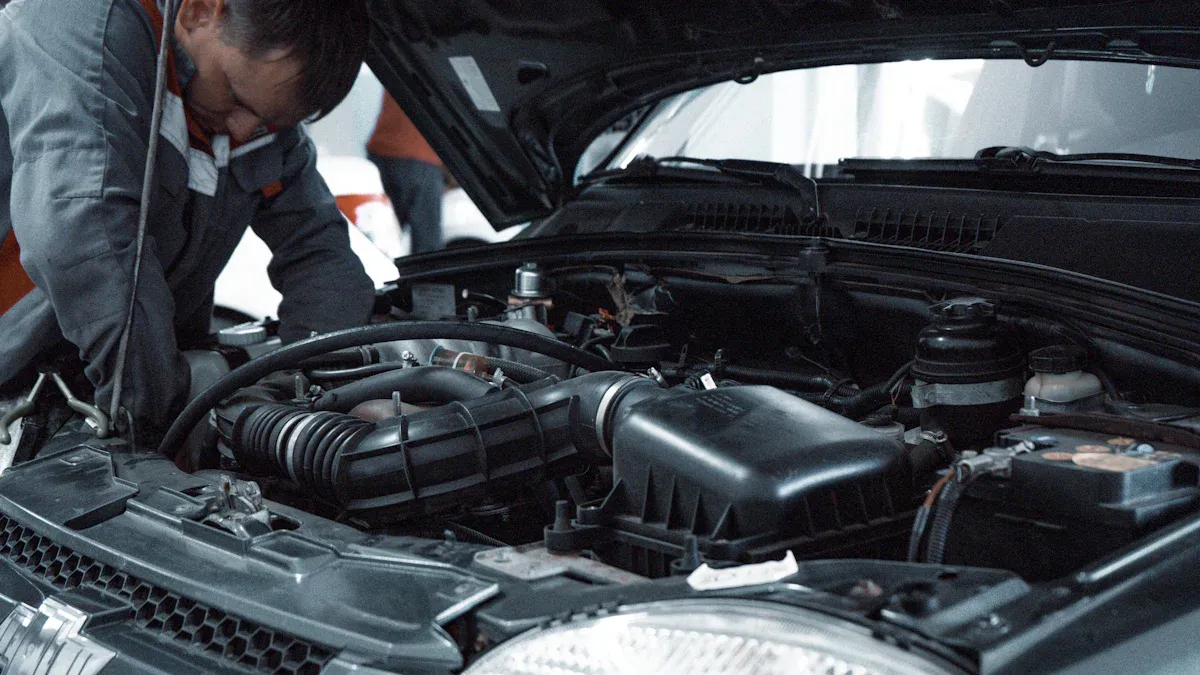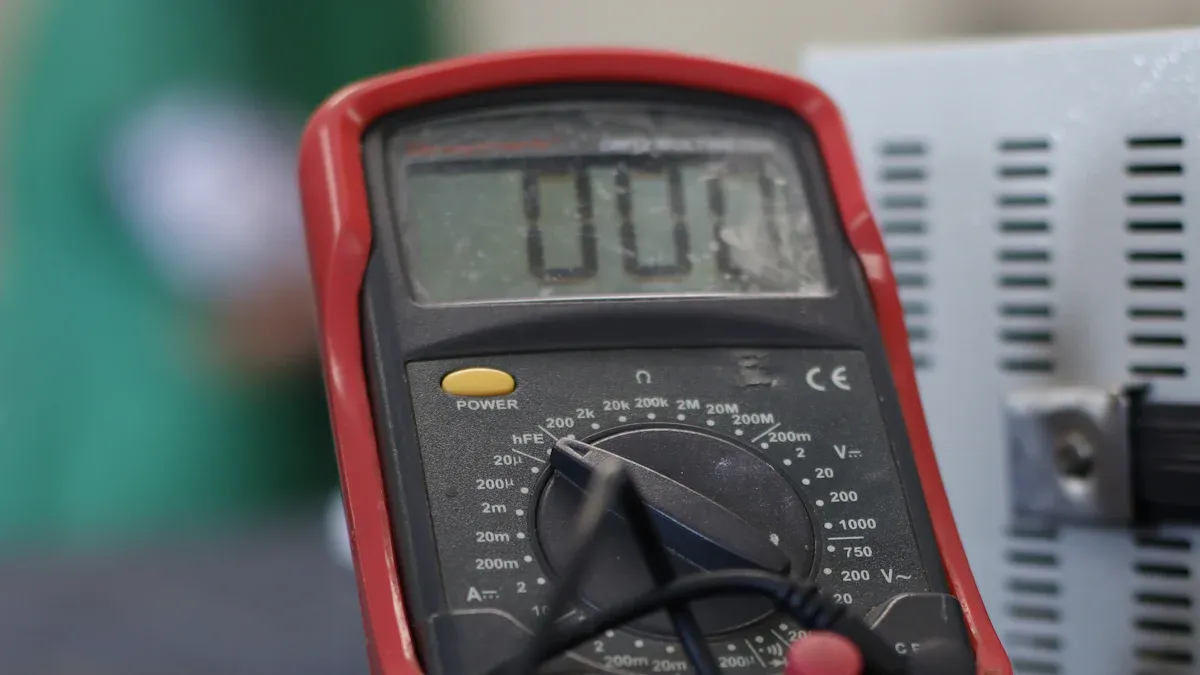What’s the Best Way to Test ABS Sensors?
Testing ABS sensors is crucial for maintaining your car's safety. When you test ABS sensors, you ensure they accurately monitor wheel speed and assist the brakes, particularly during emergencies. Using tools like a multimeter or scan tool can help identify issues and keep your vehicle operating efficiently. Research highlights that inspecting ABS systems early can reduce the risk of accidents. Before you test an ABS sensor, ensure your car is secure and equipped with the proper tools.
Key Takeaways
Checking ABS sensors is important for car safety. It makes sure brakes work well, especially in emergencies.
Use a multimeter to measure sensor resistance and voltage. This shows if the sensor is working right.
A scan tool plugs into the OBD-II port. It reads error codes and shows live data about the sensors.
Park your car on a flat surface and unplug the battery before testing. This keeps you safe while working.
Look at the sensor area for dirt or damage. Cleaning sensors can make them work better.
Learn the normal resistance and voltage levels for your sensors. This helps you find problems faster.
Replace broken wires or damaged sensors quickly. This keeps your brakes safe and working well.
Check ABS sensors often during car maintenance. This stops issues and keeps your car safe to drive.
Tools and Preparation

Tools Needed to Test ABS Sensors
Multimeter for resistance and voltage testing
A multimeter is a key tool for checking ABS sensors. It tests resistance to see if the sensor works well. It also checks voltage to confirm the sensor is active. When you spin the wheel, the multimeter shows voltage changes. This helps find problems in the sensor's circuit.
Scan tool for real-time data monitoring
A scan tool links to your car's diagnostic system using the OBD-II port. It reads error codes and shows live data about the sensor's performance. Tools like the Foxwell NT809 are great for finding ABS issues and reading codes.
Basic hand tools for accessing sensors
You’ll need simple tools like screwdrivers and wrenches to reach the sensors. These tools help remove covers or panels that protect the sensors and wires.
Safety gear for personal protection
Wear gloves and safety glasses to stay safe while testing. Gloves protect your hands from cuts, and glasses keep dirt out of your eyes.
Tool | Purpose |
|---|---|
Foxwell NT809 | Finds ABS issues and reads error codes |
Multimeter | Checks sensor resistance and confirms function |
Safety Precautions
Ensuring the vehicle is stable and secure
Park your car on a flat surface to keep it steady. This avoids accidents and helps you test the sensors properly.
Disconnecting the battery if required
Turn off the car and unplug the battery before testing. This stops electrical shocks and keeps the car’s system safe.
Using jack stands for safety
If you lift the car, use jack stands to hold it up. Jack stands keep the car stable and stop it from falling during testing.
Preparing the Vehicle
Locating the wheel speed sensors
Wheel speed sensors are near the wheel hub or brake area. Check your car’s manual to find their exact location.
Cleaning the sensor area for better access
Dirt can block the sensors and make them work poorly. Clean the area around the sensors before testing for better results.
Park the car on a flat surface to stay safe.
Turn off the car and unplug the battery to avoid shocks.
Set up your workspace and get the car ready for testing.
Step | Task |
|---|---|
1 | |
2 | Check error codes from the car's computer system. |
3 | Look at the ABS module and its connections. |
4 | Use a multimeter to test the ABS sensor's resistance. |
Step-by-Step Guide to Test ABS Sensors

Visual Check of Wheel Speed Sensors
Look for damage or wear
First, check the wheel speed sensors closely. See if there are cracks, dents, or other damage on the sensor. A broken sensor might not detect wheel speed correctly, causing ABS problems. Also, check if the sensor is securely in place and lined up properly. If it’s not aligned, it may give wrong readings or none at all.
Check wires and connectors for problems
Next, inspect the wires and connectors linked to the sensors. Look for broken wires, rust, or loose parts. Damaged wires can stop the sensor from sending signals to the ABS system. If you see rust on the connectors, clean them gently to fix the contact.
Tip: Use a flashlight to see hidden spots around the sensor and wires. This helps you find any problems you might miss.
Testing ABS Sensors with a Multimeter
Check resistance to see if the sensor works
Use a multimeter to test the sensor’s resistance. Set the multimeter to the ohms setting. Unplug the sensor from its wires and touch the multimeter probes to the sensor ends. Compare the reading to what the car manual says is normal. A good sensor will have resistance in the right range.
Multimeters test both resistance and voltage.
They are accurate within ±0.5%.
Use the right settings and connect properly for good results.
If the resistance is too high or low, the sensor might be bad and need replacing.
Test voltage while spinning the wheel
After checking resistance, test the sensor’s voltage. Switch the multimeter to AC voltage mode. Plug the sensor back into its wires and spin the wheel by hand. The multimeter should show changing voltage as the wheel turns. This means the sensor is working. If there’s no voltage, the sensor or circuit might have a problem.
Note: Always check your car manual for the correct resistance and voltage ranges for your sensor.
Using a Scan Tool to Check Wheel Speed Sensors
Plug the scan tool into the OBD-II port
A scan tool helps find ABS sensor problems. Connect it to the OBD-II port under the dashboard. Turn the key to “on” but don’t start the engine. The scan tool will talk to the ABS system and show error codes about the sensors.
Watch live data to find problems
Once connected, use the scan tool to see live sensor data. Spin the wheels and check the readings for each sensor. All sensors should show similar speeds. If one sensor shows no data or strange numbers, it might be broken.
In one example, a mechanic used a scan tool to find an ABS issue. The tool showed a problem with the sensor signal and ground. After checking, they found a loose reluctor ring was the cause. This shows how helpful scan tools are for finding sensor problems.
Tip: Compare the scan tool data to the car manual’s specs. This helps confirm if the sensor is working right.
Comparing and Interpreting Results
Understanding normal resistance and voltage ranges
Knowing the right resistance and voltage ranges is important. These numbers show if the sensor works properly. Most sensors have resistance between 800 and 2,500 ohms. Always check your car manual for exact details.
To test resistance, set the multimeter to ohms mode. Touch the probes to the sensor terminals and write down the number. If the reading matches the manual’s range, the sensor is likely fine.
Testing voltage is also key. A working sensor makes AC voltage when the wheel spins. This usually ranges from 0.5 to 1.5 volts. Use the AC mode on your multimeter to check it. Spin the wheel by hand and watch the numbers change. Steady readings in the expected range mean the sensor is healthy.
Tip: Always use your car manual for correct resistance and voltage values. Wrong numbers can lead to mistakes.
Identifying abnormal readings and their implications
Strange readings often mean sensor or circuit problems. High resistance may show a broken sensor coil. Zero or infinite resistance could mean a short or open circuit. Both need fixing quickly.
Voltage problems can also happen. No voltage while spinning the wheel might mean the sensor is broken or not lined up. Changing voltage numbers could mean dirt is blocking the sensor.
Here’s a simple chart to explain unusual readings:
Issue | Possible Cause | Solution |
|---|---|---|
Resistance too high | Broken sensor coil | Replace the sensor |
Zero or infinite resistance | Short or open circuit | Fix the circuit |
No voltage output | Bad sensor or misalignment | Adjust or replace the sensor |
Inconsistent voltage | Dirt blocking the sensor | Clean the sensor area |
Note: If you can’t figure out the problem, ask a mechanic for help. ABS issues can make driving unsafe.
By learning these readings, you can find and fix sensor problems easily. Regular checks keep your ABS system working well and safe.
Troubleshooting Common Issues with ABS Sensors
Finding Common Problems
Broken or rusty wires
Wires often cause ABS sensor problems. Over time, they can crack, break, or rust because of water and dirt. Damaged wires stop the wheel speed sensors from talking to the ABS control unit. This can cause wrong sensor codes or make the sensor stop working. Check the wires and connectors carefully. Look for broken wires, rusty parts, or loose connections.
Dirt blocking the sensor
Mud and dirt can build up around the wheel speed sensors. This happens a lot if you drive on muddy or rocky roads. The dirt can stop the sensor from reading the wheel's movement correctly. A dirty sensor sends wrong data to the ABS module, which can hurt braking. Cleaning the sensor and its area often fixes this problem.
Worn-out or bad sensors
Over time, sensors can wear out or stop working because of heat or use. A bad sensor might give wrong readings or stop sending signals to the ABS module. Use an OBD-II scanner to check if a sensor is broken. If the sensor's resistance or voltage is not normal, it needs to be replaced.
Fixing ABS Sensor Problems
Cleaning the sensor
A dirty sensor can work again after cleaning. Take off the wheel to reach the sensor. Use a soft brush or cloth to clean the sensor and its area. Don’t use strong chemicals that might harm the sensor. After cleaning, put the sensor back and test it to see if it works.
Fixing or changing broken wires
If wires are broken or rusty, fix or replace them quickly. Use a multimeter to check if the circuit works. If it doesn’t, add new wires or replace the bad section. Make sure all connections are tight and clean. Good wires will let the sensors send signals to the ABS control unit again.
Changing a bad sensor
If a sensor can’t be fixed, replace it. First, unplug the sensor from its wires. Remove any clips or bolts holding it. Put the new sensor in the same spot and reconnect the wires. Test the ABS system with a diagnostic tool to make sure the new sensor works. A new sensor helps the ABS module get correct data, improving braking.
Tip: Always check your car’s manual for steps to fix sensors or wires.
When to Get Help from a Mechanic
ABS warning light stays on
If the ABS light doesn’t turn off after fixing the sensors, the problem might be in the ABS module or control unit. A mechanic can use special tools to find the issue and fix it.
Confusing test results
Sometimes, sensor tests give strange or unclear results. For example, fixing one sensor might lead to another breaking soon after. This could mean a bigger problem in the ABS system. A mechanic can check the whole system and fix it properly.
Note: ABS systems are tricky, and wrong repairs can make driving unsafe. If you’re unsure, ask a mechanic to avoid mistakes.
Testing ABS sensors the right way keeps brakes safe. Use tools like a multimeter or scan tool to find problems. Always follow safety steps to avoid getting hurt.
Testing often makes brakes work better and lowers accident risks. Studies show checking ABS sensors early finds problems before they cause accidents.
Regular care saves repair costs and keeps your car running well. By checking sensors, you stay safe and protect others on the road. Take time to test ABS sensors for safer driving.
FAQ
What are ABS sensors, and why are they important?
ABS sensors check how fast the wheels spin. They send this data to the ABS module. This stops the wheels from locking when braking. It helps you stay in control and drive safely. If ABS sensors don’t work, your brakes might fail.
How often should you test ABS sensors?
Test ABS sensors during regular car check-ups. Also, test them if the ABS warning light turns on. Checking them often keeps your brakes working well and avoids problems.
Can you test ABS sensors without a multimeter?
Yes, you can use a scan tool instead of a multimeter. A scan tool connects to your car’s OBD-II port. It shows live sensor data. But a multimeter gives more detailed readings for resistance and voltage.
What does the ABS warning light mean?
The ABS warning light means there’s a problem with the ABS system. It could be a bad sensor, broken wires, or an issue with the ABS module. Testing the sensors can help find the problem.
Do you need to remove the wheel to test ABS sensors?
Usually, you don’t need to take off the wheel. Turn the wheel outward to reach the sensor. But for cleaning or a closer look, removing the wheel can help.
What tools are essential for ABS sensor testing?
You need a multimeter, scan tool, hand tools, and safety gear. These tools help you test sensor readings and keep you safe while working.
Can a dirty sensor cause ABS issues?
Yes, dirt can block the sensor and cause wrong readings. This can stop the sensor from sending signals. Cleaning the sensor area often fixes this problem.
When should you replace an ABS sensor?
Replace an ABS sensor if it has strange readings or is damaged. A bad sensor can make your brakes work poorly.
Tip: Check your car’s manual for steps to test and replace sensors.
See Also
Master Multimeter Techniques for Testing HVAC Capacitors
Testing Starters for Vehicles: Cars, Bikes, and Lawnmowers
Accurate Diode Testing Techniques for Circuit Analysis
